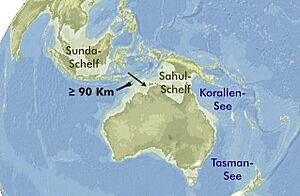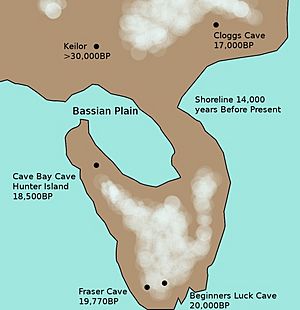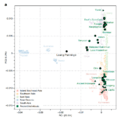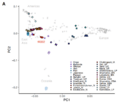Prehistory of Australia facts for kids
The prehistory of Australia is the long period before Europeans arrived in 1788. This time began when the first people came to the Australian continent. We call it "prehistory" because there were no written records from this time. Instead, we learn about it from archaeological finds like tools and ancient campsites.
Most experts believe people first arrived in Australia between 50,000 and 65,000 years ago. During this entire period, people used stone tools, so it's part of the Stone Age. Unlike some other parts of the world, Australia's first people mostly lived as hunter-gatherers until Europeans arrived. However, they were very skilled at managing the land, using practices like controlled burning and, in some places, even fish farming and permanent homes.
Contents
First People Arrive
Scientists have many ideas about how the first people, who were the ancestors of today's Aboriginal people, reached Australia. They arrived during the last part of the Pleistocene Ice Age, when sea levels were much lower than they are now. Because of all the ice, the sea level dropped by more than 100 meters!
At that time, New Guinea and Tasmania were connected to Australia, forming one huge landmass called Sahul. Even with lower sea levels, the ocean was still a big challenge. So, it's thought that these early travelers reached Australia by "island hopping" – moving from one island to the next.
Two main paths are suggested:
- One path went through a chain of islands between Sulawesi and New Guinea.
- The other path led to North Western Australia through Timor.
These journeys show that the first Australians were among the world's earliest sailors!
It's hard to know exactly when people first arrived because the areas where they likely landed are now under about 50 meters of water. However, we know for sure that humans were in Australia at least 40,000 years ago. Many ancient sites have been found from this time. For example, the Malakunanja II rock shelter in Arnhem Land is thought to be about 55,000 years old.
Near Sydney, archaeologists have found evidence that Aboriginal people lived there for at least 30,000 years. In Parramatta, they found charcoal, stone tools, and signs of old campfires. Even older stone tools, dating back 45,000 to 50,000 years, were found near Penrith. This means people were living in the Sydney area much earlier than once thought.
Evidence also shows people lived near the Swan River in Western Australia about 40,000 years ago. Tasmania, which was connected to the mainland by a land bridge, was settled at least 30,000 years ago. Some researchers believe certain sites are even 60,000 years old, but not everyone agrees on these older dates.
Fire Farming and Giant Animals
Archaeological findings, like layers of charcoal, show that fire has been a part of the Australian landscape for over 100,000 years. But over the last 70,000 years, fires became much more common. This is because hunter-gatherers started using fire as a tool. They would burn areas to:
- Drive animals for hunting.
- Encourage new plant growth, which attracted more animals.
- Clear thick forests, making them easier to travel through.
These controlled burns changed the landscape. Thick forests became more open sclerophyll forests, and open forests turned into grasslands. Plants that could handle fire, like eucalyptus and acacia, became very common.
The changes to animals were even bigger. Many megafauna (giant animals much larger than humans) disappeared. About 60 different types of large animals became extinct. These included:
- The Diprotodon family: huge marsupial plant-eaters that looked a bit like hippos.
- Several large birds that couldn't fly.
- Meat-eating kangaroos.
- Wonambi naracoortensis, a 5-meter-long snake.
- A 5-meter-long lizard.
- Meiolania, a tortoise the size of a small car.
We don't know the exact reason for these extinctions. It might have been fire, hunting, climate change, or a mix of all these things. Some people argue that careful, seasonal fires used by Aboriginal people actually helped prevent bigger, more destructive wildfires.
Between 18,000 and 15,000 years ago, Australia became much drier, with lower temperatures and less rain. Then, between 16,000 and 14,000 years ago, sea levels rose very quickly. The land bridges connecting Tasmania to the mainland, and Kangaroo Island to the mainland, slowly disappeared under the rising water. By about 9,000 years ago, these islands were completely cut off. This meant the Tasmanian Aboriginal people became isolated from the rest of Australia.
Culture and Way of Life
The last 5,000 years brought a better climate, with more warmth and rain. During this time, Aboriginal societies developed complex tribal structures. People traded many things, including:
- Songs and dances.
- Flint and precious stones.
- Shells, seeds, and spears.
- Food items.
The Pama–Nyungan language family spread across most of Australia, from Cape York to the southwest. There were also similar religious ideas and stories across the country. Some songlines (paths that follow the journeys of ancestral beings) even crossed the entire continent.
Young boys and girls had special ceremonies to mark their entry into adult knowledge. People followed strict rules about how they should behave towards family members, including uncles, aunts, brothers, sisters, and in-laws. Many communities had kinship systems that divided people into groups, with rules about who could marry whom.
Aboriginal culture was very rich and deep. They understood nature incredibly well and had detailed stories that explained the world around them. These stories, often about the Dreamtime, combined ideas about nature, the universe, religion, social rules, art, and humor into one complete way of understanding life.
Community elders, not hereditary chiefs, held political and religious power. Disagreements were settled by the community using a detailed system of tribal law. Sometimes, arguments could lead to feuds, especially if laws were broken.
Archaeological finds show that people in Australia practiced cremation of the dead 25,000 years ago, possibly earlier than anywhere else. Early artwork in Koonalda Cave is also about 20,000 years old.
In 1788, when Europeans arrived, there were likely around half a million Aboriginal people, though some estimates say a million or more. These people belonged to hundreds of different cultural and language groups. Most were hunter-gatherers with amazing oral histories and advanced ways of managing their land, developed over thousands of years.
In the most fertile areas, some groups lived in semi-permanent settlements. In the rich Murray Basin, people even practiced fish farming and stored grain in large "haystacks," which looked like agriculture to early European explorers.
Sadly, many Aboriginal populations were greatly reduced by diseases even before they had direct contact with Europeans. When Captain Cook claimed New South Wales for Britain in 1770, there were probably as many as 600 different tribes speaking 200–250 distinct languages and over 600 different dialects.
Contact with Other Cultures
Aboriginal people have no stories or memories of living anywhere outside Australia. However, those living along the northern coast had contact with visitors for thousands of years. People and goods moved freely between Australia and New Guinea, even after the land bridge flooded about 6,000 years ago.
Trade continued across the Torres Strait, which was easy to cross with its chain of islands and reefs. The Torres Strait Islanders, who were seafaring Melanesian people, settled these islands over 2,500 years ago, and they had ongoing cultural exchanges with Aboriginal people in northeast Australia.
Indonesian fishermen called "Bajau" from the Spice Islands (like Banda) fished off Australia's coast for hundreds of years. Later, Macassan traders from Sulawesi regularly visited northern Australia to fish for trepang (an edible sea cucumber) to trade with the Chinese. This contact started at least in the early 1700s.
There was a lot of cultural exchange between these groups. We can see this in:
- Aboriginal rock and bark paintings.
- New technologies like dug-out canoes.
- Items like tobacco and tobacco pipes.
- Macassan words in Aboriginal languages (for example, Balanda for a white person).
- Descendants of Malay people in Australian Aboriginal communities, and vice versa, due to intermarriage and travel.
The myths of the people in Arnhem Land tell stories of the "Baijini" people, who caught trepang and grew rice. These myths say the Baijini were in Australia even before the Macassans. Some researchers think the Baijini might have been another group of Southeast Asian visitors, like the Bajau, or perhaps a reflection of Aboriginal people who traveled to Sulawesi with the Macassans and returned.
Possible Link to East Africa
In 1944, some copper coins with Arabic writing were found on a beach on Marchinbar Island in the Wessel Islands (Northern Territory). These coins were identified as coming from the Kilwa Sultanate in East Africa. This was very unusual because only one such coin had ever been found outside East Africa before!
The coins had the name of a Kilwa Sultan, but it's not clear if he ruled in the 10th or 14th century. This discovery is interesting to historians who believe people might have reached Australia or its nearby islands before the first widely accepted European discovery by the Dutch sailor Willem Janszoon in 1606.
Images for kids
See also
 In Spanish: Prehistoria de Australia para niños
In Spanish: Prehistoria de Australia para niños





